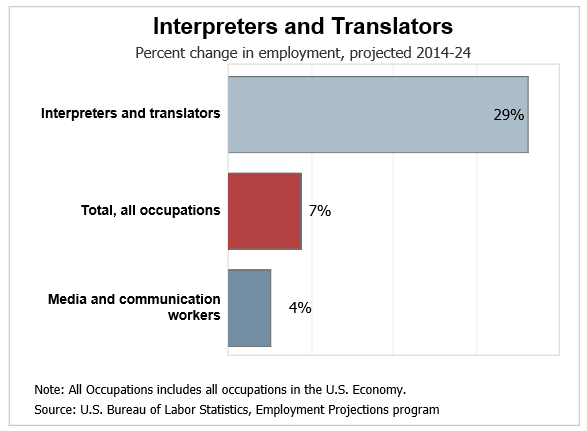Employment of interpreters and translators is projected to grow 29 percent from 2014 to 2024, much faster than the average for all occupations. Employment growth reflects increasing globalization and a more diverse U.S. population, which is expected to require more interpreters and translators.
Demand will likely remain strong for translators of frequently translated languages, such as French, German, Portuguese, Russian, and Spanish. Demand also should be strong for translators of Arabic and other Middle Eastern languages and for the principal Asian languages: Chinese, Japanese, Hindi, and Korean.
Demand for American Sign Language interpreters is expected to grow rapidly, driven by the increasing use of video relay services, which allow people to conduct online video calls and use a sign language interpreter.
In addition, growing international trade and broadening global ties should require more interpreters and translators. The ongoing need for military and national security interpreters and translators should result in more jobs as well. Emerging markets in Asia and Africa are expected to increase the need for translation and interpreting in languages spoken on those continents.
Computers have made the work of translators and localization specialists more efficient. However, these jobs cannot be entirely automated, because computers cannot yet produce work comparable to the work that human translators do in most cases.
Job Prospects
Job prospects should be best for those who have at least a bachelor’s degree and for those who have professional certification. Those with a master’s degree in interpreting and/or translation also should have an advantage.
In addition, urban areas—especially Washington, DC; New York; San Francisco; and Los Angeles—should continue to provide the largest numbers of jobs, especially for interpreters.
Job prospects for interpreters and translators should also vary by specialty and language. For example, interpreters and translators of Spanish should have good job prospects because of expected increases in the population of Spanish speakers in the United States. Similarly, job opportunities should be plentiful for interpreters and translators specializing in healthcare and law, because of the critical need for all parties to fully understand the information communicated in those fields.
In addition, there should be many job opportunities for specialists in localization, driven by the globalization of business and the expansion of the Internet.
Interpreters for the deaf will continue to have favorable employment prospects because there are relatively few people with the needed skills.
| Occupational Title | SOC Code | Employment, 2014 | Projected Employment, 2024 | Change, 2014-24 | Employment by Industry | ||
|---|---|---|---|---|---|---|---|
| Percent | Numeric | ||||||
|
SOURCE: U.S. Bureau of Labor Statistics, Employment Projections program |
|||||||
| Interpreters and translators | 27-3091 | 61,000 | 78,500 | 29 | 17,500 | [XLSX] | |
[:]]]>





